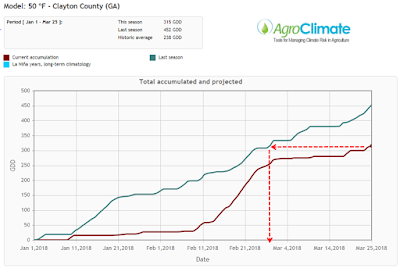I was hoping to simplify my tracking of spring bloom markers, but instead I added another marker, Growing Degree Days (GDD), which is easy to calculate using free web-based tools. Julian Day allows me to convert MM-DD-YYYY date format which spans 3 months (February to April) into a seamless day of the year format. GDD is a major convenience, I can tap into a database of daily temperature minimum and maximum instead of recording my own observations. Focusing on the last two graph points, the accumulated warming this year is roughly 25 days delayed compared to last year (84 versus 59).
Here I compare additional observations with GDD, 1) Acer leaf-out in my backyard and 2) first day that the pollen count exceeds 1000. Notice how well these markers follow similar graph trends.
Here I show a free web-based tool by AgroClimate which compares this year's GDD to the previous year. Reading from left-to-right, notice where the curves depart - last year's accumulated warming began in mid January, approximately 30 days earlier than this year. If the daily high does not exceed 50°F, then the daily contribution to accumulated GDD is zero - the curve does not grow in height. I love this graph layout, but I can't use this tool to go back further in history. This tool can draw the average GDD (not shown), but we all know that no such thing exists in the wild - we have never experienced an average year of weather.
Here I show a free web-based tool by Weather Underground which I used to calculate GDD beyond the previous year in history. In previous years, I kept the starting point equal to January 1, and I change the ending point in a trial and error manner to achieve a GDD value close to 296. Why 296 - this is the GDD value where the Atlanta pollen count exceeds 1000 this year.
2009 2010 2011 2016 2017 2018
day day day day day day
Bradford Pear 65 79 60 56 53Carpenter Bees 68 87 72 63 77
Acer palmatum leaf out 73 92 77 64 76
Carolina Cherry Laurel 73 97 83 57 76
Pollen Count over 1000 76 51 84
GDD=296 (base 50°F) 92 104 93 84 59 84
Here I show other values that do not appear in the graphs.




No comments:
Post a Comment